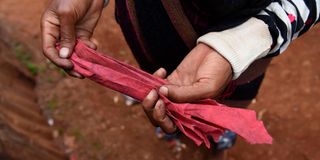Remove the stain, promote menstrual hygiene equity

A woman holds a piece of cloth she uses as sanitary pad in Kangemi on October 18, 2022. For lack of money to buy pads, some women use pieces of clothes. Actors in the menstrual hygiene space should find the World Bank’s (2021) Menstrual Health and Hygiene Resource package useful as a guide.
What you need to know:
- The Ministry of Health’s 2020 Menstrual Hygiene Policy notes that 58 per cent of girls in rural settings and 53 per cent in urban areas in Kenya cannot afford sanitary pads.
- Over the years, the government has initiated measures on the subject although these are constrained by a number of factors.
- Even when prices temporarily fall, it is counterbalanced by poverty - the needy populations' earnings in a day is far lower than the cost of pads.
As we continue to focus on inclusion in March as the women’s month, it is important to remember one area where many girls and women remain excluded, namely menstrual health management. The Ministry of Health’s 2020 Menstrual Hygiene Policy notes that 58 per cent of girls in rural settings and 53 per cent in urban areas in Kenya cannot afford sanitary pads and, therefore, resort to unsuitable substitutes. This denies girls and women of dignity, much as it is also associated with absence from school during menses.
Over the years, the government has initiated measures on the subject. It repealed the value added tax on sanitary pads in 2014, removed duties on raw materials needed to produce them in 2016, and allocated an annual budget of $3 million to fund the distribution of free sanitary pads in schools in 2011.
It also amended the Basic Education Act to mandate provision of “free, sufficient, and quality” sanitary pads to girls in public primary schools in 2017 and approved the Menstrual Health and Management Policy 2019–2030.
Encouraging as they are, the steps are constrained by a number of factors. The World Bank’s 2022 case study “The enabling environment for menstrual health and hygiene” is critical of tax reforms for their “minimal effect on the price of imported and locally made products”. For instance, it refers to a 2020 study, “An economic assessment of menstrual hygiene product tax cuts” by Rossouw, L and H. Ross, which reveals that the “price of sanitary pads in Kenya remains one of the highest in the region” partly due to domination of the market by one multinational corporation which controls 63 per cent of the portfolio.
Needy population
Even where the prices have temporarily fallen, this is counterbalanced by poverty as what the needy populations earn in a day is far lower than the cost of pads. The brief further notes lack of evidence on the impact of the free sanitary pads programme on school girl attendance. It, therefore, observes that “women and girls in Kenya continue to face significant challenges in adequately and safely managing their menstrual health and hygiene” where such include inadequate security, privacy and water in girls’ school latrines. It cites a study which revealed that 68 per cent of women in an informal settlement in Nairobi, “reported experiencing violence, in part due to limited access to private toilets”.
The study surmises that “assessments may reveal that tax policy changes are not the most effective tool in ensuring that menstrual products are affordable, particularly for low-income consumers”. It, therefore, proposes alternative fiscal solutions, “such as subsidies or cash-transfer programmes or incentives for local enterprises and social entrepreneurs to produce locally”.
This reminds us that sanitary pads come in disposable and re-usable forms, the former being the default product in Kenyan shops, and the latter only gaining popularity, thanks to social entrepreneurs.
It is this context that the Kenya Bureau of Standards guidelines for the production of safe and quality reusable sanitary pads (Kenya Standard – KS 2925:2020 Reusable Sanitary Towels Specification), released in December 2020 comes to mind. The objective of the guidelines is to ensure “quality and affordable reusable sanitary pads, especially for women and girls in low income areas who are currently forced to use clothes or other unhygienic materials, or for students”. The standards address quality and performance factors such as absorbency, fastening, comfort and functionality, feel, skin sensitivity, odour, aesthetics, noisiness and ease in use.
Distribution networks
Re-usable pads are cheaper in the long run as a pack of five can be used for a whole year if properly maintained. Some studies show, however, that women in poor habitations find them inconvenient because of lack of water and private quarters to air them.
The Kebs guidelines should motivate enterprises to expand their outputs and distribution networks. One question remains, though. Will they adhere with the standards or flood the market with inferior products for quick gain?
The government can also use this as an opportunity to empower women’s enterprises economically by funding them to produce pads through its Affirmative Government Procurement Opportunities and by buying them for the school programme. By doing this, it will have addressed cost, physical access, economic empowerment, girls’ absenteeism and their exposure to sex pests extorting them in return for the pads.
Meanwhile, actors in this space should find the World Bank’s (2021) Menstrual Health and Hygiene Resource Package useful as a guide “on how to design and monitor effective, inclusive, and sustainable menstrual health and hygiene initiatives”.
As the package explains, menstrual health management matters for: inclusion of girls in education; reduction of infections; promotion of dignity and self-efficacy; improvement of sexual and reproductive health; economic activity; creation of employment; and improved environmental management.
The writer is an international gender and development consultant and scholar ([email protected])





